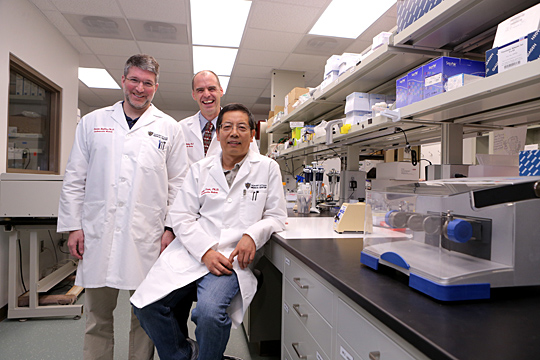Chronic kidney disease affects nearly 25 percent of the adult population in the United States. It is closely associated with cardiovascular disease and can lead to a patient requiring dialysis or kidney transplant.
Researchers at The University of Toledo are exploring the connection between the kidney and heart in an effort to understand the molecular mechanisms, which can help develop new treatments to improve patient outcomes.

Dr. Steven Haller, left, Dr. David Kennedy, center, and
Dr. Jiang Tian are examining the connection between the kidney and heart.
UT researchers, in collaboration with Marshall University and New York Medical College, identified a peptide that could reduce kidney disease-related cardiac fibrosis in mice, which could potentially lead to the development of new treatment options for patients diagnosed with kidney disease.
“We know patients with kidney disease often develop cardiac fibrosis, which is a condition where their heart tissue becomes damaged and scarred,” said Dr. Jiang Tian, associate professor of medicine and lead co-author of the study. “Cardiac fibrosis was previously thought to be untreatable, but this new discovery shows promise for reversing or preventing the condition.”
The research builds upon pioneering work by co-author Dr. Zijian Xie, director of the Marshall Institute for Interdisciplinary Research, who discovered a new function of the Na/K-ATPase during his tenure at UT. Xie found that the Na/K-ATPase can mediate cell signaling in addition to its role in regulating the potassium and sodium level in each cell of the body.
The research team subsequently learned that dysfunction of kidneys signals the body to produce steroids that bind to the Na/K-ATPase, but that a long term “off-target” effect of this causes scarring to develop in the heart.
“We discovered that these sodium-potassium pumps don’t just move sodium and potassium around, but they are multitasking proteins that are involved in other functions as well,” said Dr. David Kennedy, assistant professor of medicine and co-author of the study. “It’s like finding out your car is a spaceship and you didn’t even know it.”
When the team introduced a peptide called pNaKtide in a mouse model with kidney disease, the associated cardiac fibrosis was reduced.
“We are excited about these findings and will further explore the possibility to use this peptide as a therapeutic treatment for cardiac fibrosis,” Tian said.
In a related UT study, Dr. Steven Haller, assistant professor of medicine discovered use of the immunosuppressant drug Rapamycin also helps in reducing cardiac fibrosis in animal models with kidney disease.
“Given that we now know Na/K-ATPase signaling is known to initiate events that leads to cardiac fibrosis, we can look at ways to interrupt this sequence,” Haller said. “Rapamycin inhibits an enzyme implicated in the progression of many different forms of kidney disease, and we now know it also regulates a pro-fibrotic steroid, which binds the Na/K-ATPase and causes fibrosis.”
The study, “Rapamycin Attenuates Cardiac Fibrosis in Experimental Uremic Cardiomyopathy by Reducing Marinobufagenin Levels and Inhibiting Downstream Pro-Fibrotic Signaling,” was published in the Journal of the American Heart Association.